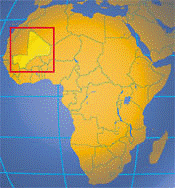International Sorghum and Millet Collaborative Research Support Program (INTSORMIL CRSP)
Date of this Version
9-17-2010
Document Type
Article
Citation
USAID SUCCESS STORY (September 17, 2010)
Abstract
“Before 2006, we were not self-sufficient in millet because the yields were very poor. But thanks to the introduction of the “Toroniou” cultivar from the INTSORMIL project farmers are becoming more skilled in millet production. Now many farmers in this village are able to meet their home consumption in millet and make more money.” Siriki Diarra, president of the cooperative “Yeretaton” for millet production in Tingoni, expressed his appreciation for involvement in the IER-INTSORMIL project financed by USAID-Mali.
Millet is the main crop grown and consumed in the village of Tingoni located in the Ségou region of southern Mali. However, average yields of the local variety were usually low, no more than 0.8 to one ton/ha in good years. Farmers could barely meet their family home consumption. Continuing soil depletion in the village and the lack of access to credit for fertilizer resulted in low millet yields. Since 2006, the Production- Marketing component of the IER-INTSORMIL project has introduced a millet cultivar “Toroniou” and has trained Tingoni farmers in the use of improved agricultural techniques and marketing strategies to increase millet productivity, prices, incomes, and food security.
In 2009, a year after their graduation from the project, farmers’ yields for the improved cultivar were still high. Yields average 1.5 tons/ha and reach 2.3 tons per hectare for the best farmers. These yield achievements have no precedent in the village. Farmers used the increased income from millet to satisfy their household consumption requirements, meet family expenses and buy clothing and other gifts for women and children.


